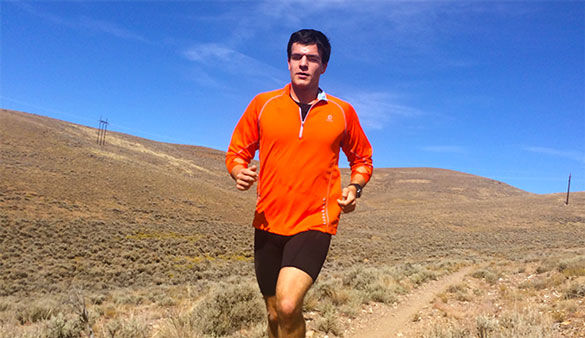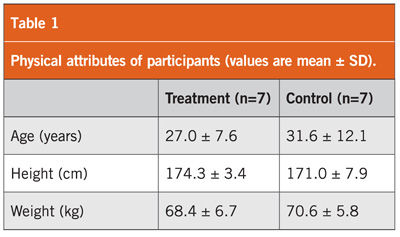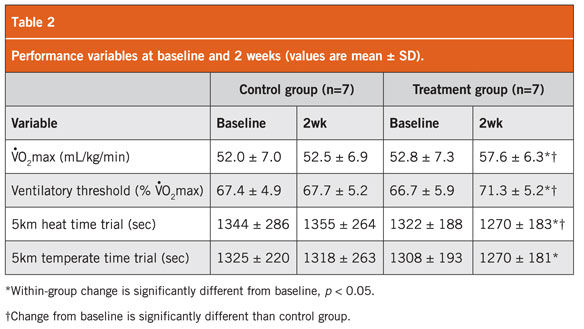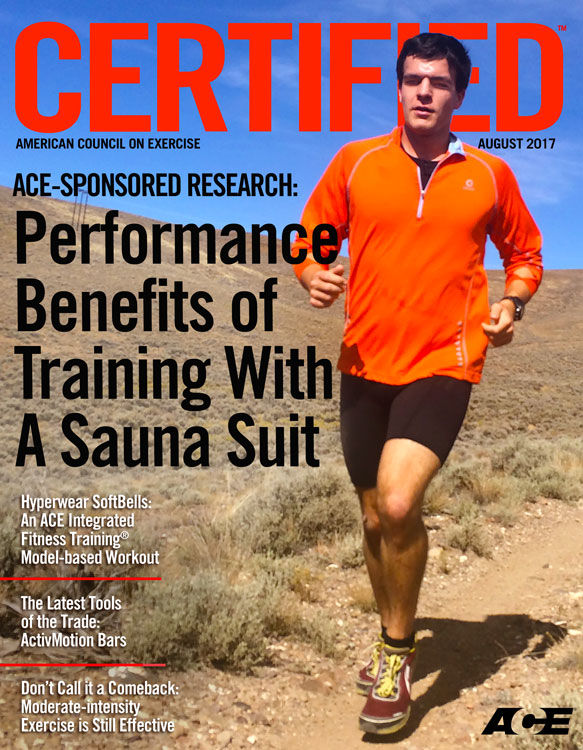
Sauna suits have come a long way since the 1980s and ‘90s, when stories of celebrities suffering heat exhaustion or even heat stroke while wearing garbage bag–like suits under their sweats would show up in the newspaper from time to time. Sauna suits have evolved almost as much as the ways in which we get our news since those days, as exemplified by the Kutting Weight sauna suits, which are the focus of this research study.
The suits, which are made of Neoprene and are similar to a wetsuit, can be worn on their own, or under clothes like shorts and a T-shirt if an individual is uncomfortable exercising in the sauna suit alone. According to the manufacturer, the Kutting Weight suits will “amplify your workouts for increased results” in several ways, including increasing your body temperature more quickly, enabling you to burn more calories, and increasing your mental and physical toughness.
Environmental stressors, including heat and/or humidity, can drastically impact endurance performance. There is ample research on the physiological adaptations that take place with consistent heat exposure, as well as how exposure might affect endurance performance. Stated simply, without proper acclimation, heat stress can impair performance by shortening the time it takes an athlete to become fatigued.
Can short-term use of sauna suits during training improve endurance performance by providing a novel means of heat acclimation prior to competition?
ACE enlisted the help of Lance C. Dalleck, Ph.D., and his team of researchers in the High Altitude Exercise Physiology Program at Western State Colorado University to investigate whether wearing the Kutting Weight sauna suits would provide adequate heat acclimation to improve performance during an endurance event.
The Study
The researchers recruited 14 people (12 men, two women) to participate in this study, half of whom were in the “treatment” group and half of whom were in the control group. It’s important to highlight the fact that, in addition to being low-risk and free of any cardiovascular, pulmonary or metabolic disease, the participants were highly trained endurance athletes. Each individual had six or more years of endurance training and competition experience, and trained for seven to 12 hours each week.
All participants were acclimatized to the altitude at Western State Colorado University, which sits at 7700 feet (2350 meters) above sea level, and the study was scheduled during a period when there were no competitions planned. The physical attributes of the participants are presented in Table 1.

Prior to the onset of the study, the 14 participants underwent a battery of physiological and performance assessments. The order of the tests was randomized to prevent an “order effect,” the participants were instructed to avoid the consumption of alcohol or caffeine for at least 24 hours before each assessment, and there was a minimum of 48 hours between visits to the lab.
During one visit, they performed a maximal exercise test on a treadmill to measure their maximal oxygen uptake (VO2max). A metabolic analyzer was used to establish each participant’s VO2max.
During another visit, they completed a 5K time trial on a treadmill in a simulated hot environment (approximately 95° F/35° C). Participants were instructed to give maximal effort; the pace was initially set to each participant’s personal best in a 5K race.
Finally, during a third visit to the lab, they again completed a 5K time trial, this time in a temperate environment (approximately 64° F/18° C). The same instructions were given to the participants during this test as during the hot-environment run.
Prior to each of the 5K time trials, each participant was weighed, so that weight lost through sweating could be measured via a second weighing immediately after the run. In addition, heart rate, ratings of perceived exertion, core body temperature and time elapsed were recorded every 400 meters and at 5000 meters (i.e., the end of the 5K run).
After the completion of the baseline testing, the participants were paired according to sex, VO2max and their personal best times on the 5K runs, and then randomized into the treatment and control groups so that the groups were as equal in terms of fitness level as possible.
The design for the two-week period after the baseline testing could not have been simpler. The athletes who took part in this study were instructed to complete their usual training volume and intensity for 14 days and log all of their exercise. The only difference between the two groups was that the treatment group wore the Kutting Weight sauna suit during all workouts while the control group did not.
The participants repeated the same tests used as a baseline after the study period was complete.
The Results
Each of the 14 participants completed between 10 and 14 training sessions over the two-week trial. Importantly, there were no adverse events experienced by the athletes wearing the sauna suit and all physiological responses were within normal ranges. The training volume and intensity were consistent between the two groups as well as with each individual’s baseline training levels.
The performance outcomes for all participants at baseline and post-training are shown in Table 2. As you can see, there were significant improvements in VO2max, ventilatory threshold, and 5K heat and temperate time trials in the treatment group. All performance outcomes were unchanged in the control group.

There were other significant findings as well. The participants who had worn the sauna suit for the duration of the two-week training period lost significantly more weight through sweat during the heated 5K assessment than the control group (1.01 kg vs. 0.61 kg), while their core temperature was significantly lower than it was during the baseline testing. As explained by Dr. Dalleck, “Sweating earlier and more heavily helped the athletes maintain thermoregulation more effectively.”
Finally, the heart-rate responses throughout the 5K heat time trial were similar for the two groups, despite the fact that those who had worn the sauna suit during the training period saw significant increases in their speed that the control group did not.
The Bottom Line
The primary finding of this study is that short-term training in a sauna suit improves heat acclimation and endurance performance. The researchers state that these findings “support the use of a practical and portable sauna suit as a form of heat acclimation to enhance aerobic capacity and endurance performance.”
So, what does this mean to you as a health and fitness professional?
If you are working with athletes, the sauna suit is an excellent tool to add to your training arsenal. “Different environmental stressors cause different adaptations in the body,” explains Dr. Dalleck. Athletes are always looking for a training edge, and sauna suits provide that edge.
Think about athletes training in environments like the one found at Western State Colorado University. For much of the year, runners at the university will be able to see their breath when training outdoors. The fact that they rarely get to train in the heat would put them at a significant disadvantage during competitions that take place in the heat and humidity—and, relatively speaking, almost anywhere is going to be hot and humid compared to the Rocky Mountains.
“By training in a sauna suit during the weeks leading up to a competition,” says Dr. Dalleck, “athletes can better adapt to performing in the heat by simulating the conditions of the competition in a way that the local environment might not allow.”
The athletes who took part in this study saw a 3% increase in their speed after only two weeks of training in the sauna suit. That may not seem like a huge improvement, but it can easily represent the difference between victory and defeat.
If you have clients who compete in endurance events in the heat—for example, runners, triathletes or tennis players—the sauna suit just may facilitate the improvements that will take their performance to the next level.
Why Does ACE Sponsor Fitness-related Research Studies?
This study was sponsored by the American Council on Exercise. For more than 20 years, ACE has commissioned independent research studies from major universities and trusted partners across the country, covering everything from infomercial fitness products to the effectiveness of some of the hottest trends in health and fitness. ACE is committed to investing in these studies as part of its mission to promote the benefits of physical activity and to protect people from unsafe and ineffective fitness products and trends. You can find more information about past ACE-sponsored studies, including research on the best abdominal exercises, kettlebell workouts and Zumba, by clicking here.











